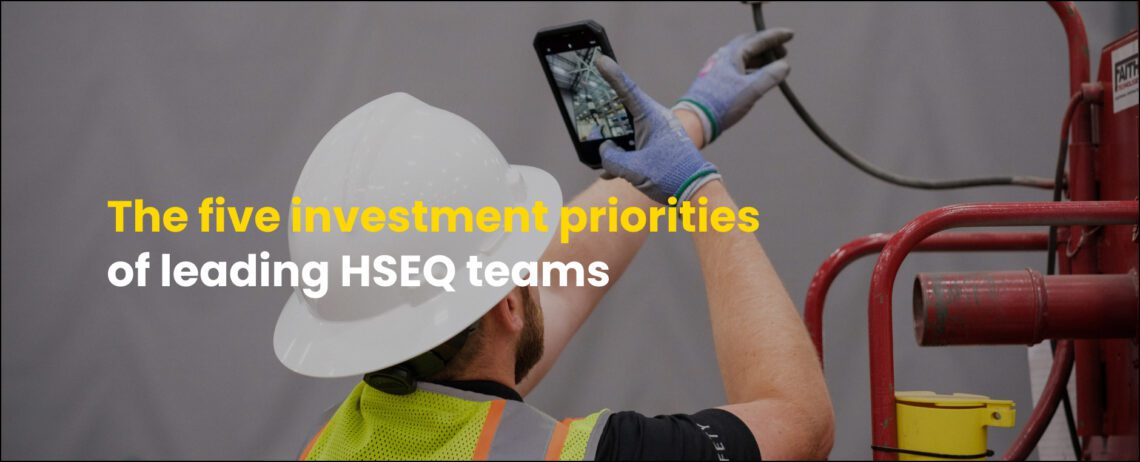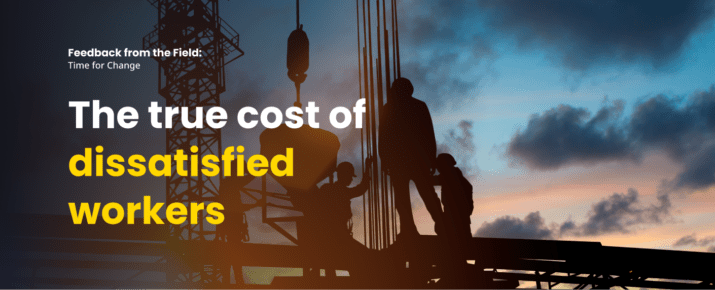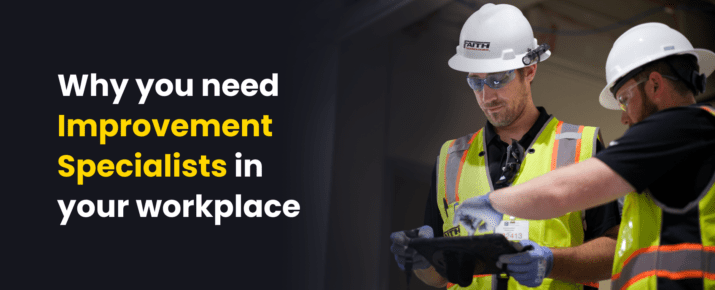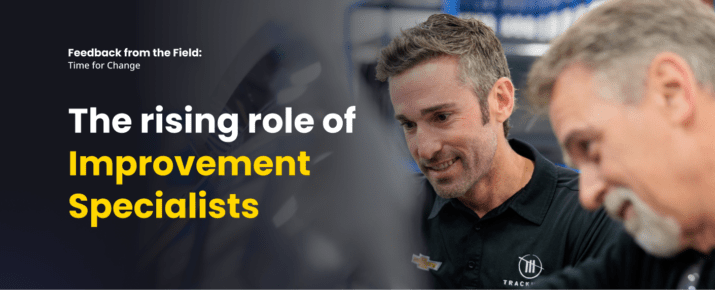Where are the best HSEQ teams spending their time?
World Of Work | By | 11 Jun 2024 | 4 minute read

There’s no doubt today’s frontline industries look very different from ten or even five years ago.
The rapid rise of technologies and tooling, set against the backdrop of ongoing safety concerns, ESG commitments, labour shortages and supply chain issues, means that organizations are in unchartered territory. There has never been a better time—or greater need—for new strategies to shape better ways of working.


With all these forces at work, how are HSEQ (health, safety, environment and quality) teams priming the frontline for long-term success?
We have some ideas. A recent Verdantix study surveyed leading companies in frontline industries to uncover their investment priorities.
Let’s look at their top 5 focus areas for these high-performing HSEQ teams and unpack some steps you can take within your own organisation to follow suit.
1. Doubling down on safety fundamentals
Addressing foundational safety concerns remains a core focus for HSEQ teams. When polled on the priorities for their HSEQ functions over the next two years, reducing serious injuries and fatalities (SIFs) came out on top (44%).
There’s a lot to be done around risk management and hazard reduction to help prevent injuries and fatalities. But if we’re talking about the fundamentals, there’s one thing workplaces need to get right from the get-go. And that’s reporting.
Here are some ways get started:
- Start with psychological safety: Review your workplace policies and reconsider the value of retaliative action. Instead, encourage open lines of communication. When employees feel comfortable consistently reporting near misses, minor mistakes, and first aid, you can be confident you’re getting the full picture. Now, you have essential data points to inform incident prevention. To further bolster your safety efforts, integrate time and attendance software. This technology can provide valuable insights into workforce patterns, helping you identify potential issues related to shift work, employee fatigue, and overall compliance. By combining psychological safety with comprehensive time and attendance system, you create a more robust framework for preventing incidents and fostering a healthier, more proactive work environment.
- Simplify reporting workflows: Give teams an easy and anonymous way to make a report, such as with capture-and-notify technology like QR codes. By making it simple for anyone on the ground to raise issues, you can make under-reporting a thing of the past.
Have you tried SafetyCulture’s Issues feature? Each issue has its own audit trail, which logs comments, media attachments, as well as field updates in real-time. This means all parties involved in the issue can collaborate in one space to resolve the problem.
2. Curating top-tier training
In the past, workplace training efforts were more preoccupied with compliance numbers than tangible learning outcomes. Now, the ability to deliver effective learning fast is critical for businesses.
The benefits of training are far reaching, from improved retention to increased productivity. And companies on the frontline recognize this, with 40% of those surveyed citing increasing engagement with HSEQ training as a high priority.


Here’s how you can tailor your training to get results:
- Train the way your team works: Configure training that fits into your team’s workflow – think virtual, bite-sized micolearning courses. Training on the SafetyCulture platform is accessible on any device, meaning you can offer upskilling opportunities to everyone, no matter where they are.
- Focus on hyper-specific courses: Rather than a one-size-fits-all approach to education, focus on creating microlearning courses on relevant content for teams – for example updated industry regulations or new ESG procedures.
- Link training and performance: Turn insights into action with the SafetyCulure platform. From Analytics, spot trends in failed items, then generate a course to bridge the demonstrated knowledge gaps in just a few clicks.
3. Watching out for our most vulnerable workers
When it comes to frontline work, contractors and lone workers have a different experience to most. Lone workers often find themselves exposed to unique hazards in their solo work environments. And contractors contend with the heightened safety issues and high-stakes regulatory compliance around temporary work.
Improving management and visibility in these areas is another major priority for HSEQ teams. Emerging technology can do a lot of heavy lifting here – let’s explore some of the ways new tooling is changing the game:
- Vehicle telematics: Introduce a new level of fleet visibility to help safeguard your contractors and lone workers. Vehicle telematics solutions deliver real-time updates around a vehicle’s location, performance diagnostics, how it’s being used, and it’s speed, to better facilitate driver safety and optimal vehicle usage.
- Seamless contractor management: Streamline your contractor management workflows with SafetyCulture. Contractors can upload their documentation, check-in, and complete onboarding, in one platform.
- Personal safety devices: Cloud-based technology like SHEQSY ensures that managers have the tools to monitor and communicate with remote workers efficiently, with features like GPS tracking, emergency alerts, and two-way communication.
4. Tapping into real-time data
Frontline workforces have historically grappled with a landscape of siloed information, paper-based processes, and legacy systems. But HSEQ teams are ready to drive change.
The fact is, siloed data blocks optimization. And with ESG compliance becoming a more pressing goal across all industries, a single repository of knowledge is needed.
So how can companies make use of real-time data to connect the dots?
- Sensors: Sensor-based data is especially useful for environmental compliance. Temperature sensors can keep a pulse on energy wastage, such as unnecessary heating or poor insulation. It can also help avoid stock loss, keep teams safe, and avoid downtime.
- A single source of truth: Consolidating data via a single operations platform can help companies make better decisions with a holistic view of their compliance, health and safety, and operational risk. With risk assessments, incident reports, and asset history in one place, it’s easier to complete audits to meet internal and external reporting requirements.


5. Experimenting with emerging technology
In 2023, the novelty factor was high as AI took the world by storm. But savvy business leaders looked past the gimmick factor and started incorporating AI into daily workflows.
The same applies to frontline teams, where there’s a growing interest in applying AI technology within HSEQ functions. 41% of those surveyed want to increase deployment through further integration or pilot projects.


How can teams leverage AI to address HSEQ challenges?
- Predict safety risks: AI can use existing data to analyze leading indicators to predict safety risks, bolstering risk management and reflecting a shift from a reactive to a proactive safety approach.
- Break down language barriers: Instant translations of key virtual documents and training materials can increase accessibility. SafetyCulture’s AI-powered platform translates courses into your choice of 100+ languages.
- Answers and guidance: Surface the right information at the right time with an AI-powered knowledge system. Enable in-the-moment answers to equip your frontline with the right information at their fingertips.
Like what you see? Have a read of these:
- Top reasons workers are cutting corners with health and safety at work
- Top environmental, health and safety (EHS) trends for 2024
- The surprising thing frontline workers care about (even more than pay)
Important Notice
The information contained in this article is general in nature and you should consider whether the information is appropriate to your specific needs. Legal and other matters referred to in this article are based on our interpretation of laws existing at the time and should not be relied on in place of professional advice. We are not responsible for the content of any site owned by a third party that may be linked to this article. SafetyCulture disclaims all liability (except for any liability which by law cannot be excluded) for any error, inaccuracy, or omission from the information contained in this article, any site linked to this article, and any loss or damage suffered by any person directly or indirectly through relying on this information.





